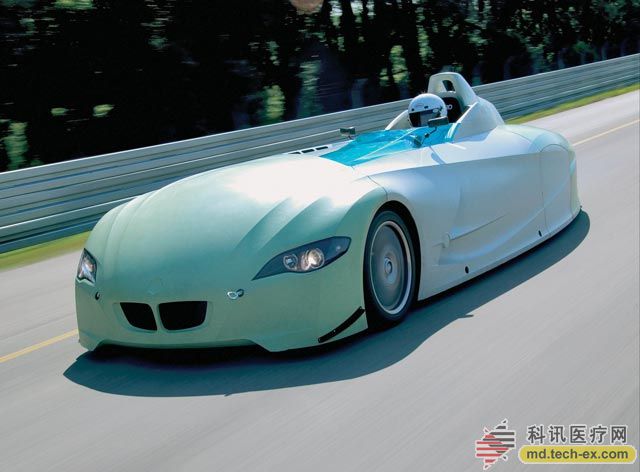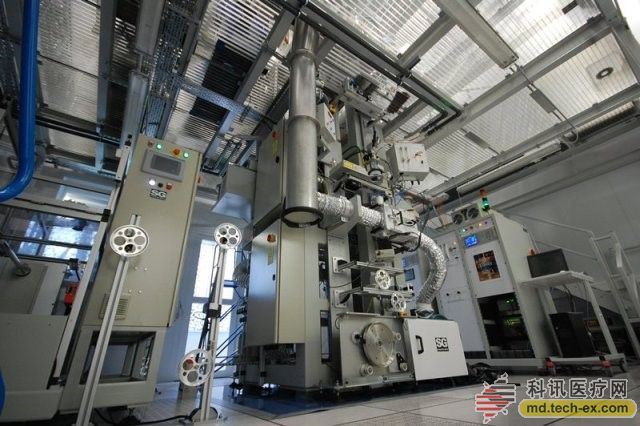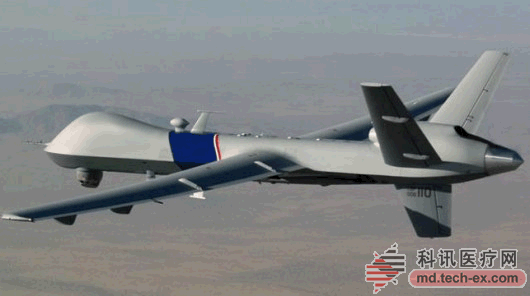Top Ten Emerging Technologies in 2015
Release date: 2015-09-11
The World Economic Forum released the top ten emerging technologies in 2015, and the top ten breakthrough scientific and technological advancements such as flying robots and human brain chips were selected.
This list is published annually and is selected by the World Economic Forum's Emerging Technologies Cross-border Council to select the most promising technology for the long-term global challenges of the year, with the aim of drawing attention to the potential and risks of emerging technologies.
This year's top ten emerging technologies reflect the tremendous power of innovation in improving people's lives, driving industry change and maintaining the planet's ecology.
Fuel cell vehicle

The picture shows the BMW H2R fuel cell car
Unlike a battery, a fuel cell does not require external charging. It can directly generate electricity by using fuels such as hydrogen and natural gas. In use, the fuel cell and the battery work together, the fuel cell is responsible for generating electricity, and the battery is responsible for storing electricity. Therefore, fuel cell vehicles are hybrid vehicles and are likely to be equipped with a feedback brake system.
The performance of a fuel cell vehicle is comparable to any conventional fuel car. Fuel cell vehicles have long cruising range. A tank of fuel can travel up to 650 kilometers (the fuel is usually compressed hydrogen), and it takes only 3 minutes to fill a tank of hydrogen fuel. Hydrogen is a clean fuel, and water vapor is the only emission from its combustion. Therefore, a hydrogen-fueled fuel cell vehicle will achieve zero emissions.
Large-scale production of low-cost hydrogen is not an easy task, and the lack of hydrogen delivery infrastructure is also a major challenge. We must build the infrastructure as much as the gasoline and diesel stations, and eventually replace the gasoline and diesel stations. At present, long-distance transportation of hydrogen, even in a compressed state, is not economically feasible. Fortunately, new hydrogen storage technologies, such as organic liquid transport devices that do not require high-pressure storage, can quickly reduce long-distance transportation costs and reduce the risk of gas storage and leakage.
2. Next generation robot
The advancement of robotics has gradually made human-machine collaboration a reality that can be seen everyday. More powerful, lower-cost sensors give robots a better insight into the surrounding environment and react. Designers draw inspiration from the great flexibility of complex biological structures such as human hands, creating robots that are getting better and more flexible. In addition, thanks to the development of the cloud computing revolution, robots are increasingly connected, and instructions and information can be obtained remotely, eliminating the need to program fully automatic machines.
With the advent of the new era of robots, these robots have gradually stepped down the assembly line of large manufacturing industries and moved to more diverse jobs. By using satellite positioning technology, robots can be used like smartphones to assist in weeding and harvesting, and to promote the precision of agricultural operations. Japan has begun a pilot of robotic nurses that help patients get out of bed, support stroke patients, and help patients regain control of their limbs.
Smaller, more flexible robots have also been introduced, and these robots can be easily programmed to handle manufacturing tasks that are labor intensive or uncomfortable.
3. Recyclable thermoset plastic

The picture shows the tableware made of thermosetting plastic.
Plastics are divided into thermoplastics and thermosets. Thermosetting plastics can only be heated in one time and molded at one time. After heating, the thermosetting plastic molecules change and undergo "hardening", even if they are subjected to high temperature and high pressure, their shape and strength will remain unchanged.
The properties of thermosets themselves make them indispensable in modern manufacturing, but they also make them impossible to recycle. Ultimately, most thermoset polymers can only be turned into landfill for landfill.
In 2014, significant progress was made in this area, and Science published a landmark article announcing the discovery of a new type of thermoset polymer that can be recycled. The polymer, called polyhexahydrotriazine (PHT), can be dissolved in a strong acid to break the polymer association, separate the monomer fraction, and then recombine into new products.
We hope that recyclable thermoset polymers can replace non-recyclable thermoset plastics in five years and achieve full coverage in newly produced products by 2025.
4. Precision genetic engineering technology
Traditional genetic engineering has been controversial. However, new technologies are emerging that allow us to directly “edit†the plant's genetic code to improve plant nutrients and better adapt to climate change.
These technologies include zinc finger nucleases (ZFNs), transcription activator-like effector nucleases (TALENS), and the recently introduced CRISPR-Cas9 system, which has evolved into a viral defense mechanism in bacteria. Such systems use ribonucleic acid molecules to lock target DNA and cleave in a target genome according to a known set of user-selected sequences. In this way, it is possible to suppress unwanted genes or to modify the genes to perform the same function as natural variations. By using "homologous recombination", CRISPR can also be used to accurately map new DNA sequences or even complete genes into the genome.
Another area where genetic engineering is expected to make significant progress is the use of RNA interference technology (RNAi) on crops. RNA interference can effectively prevent viral and fungal pathogens, protect plants from pests and diseases, and reduce the need for chemical pesticides. Viral genes have been widely used to protect papaya trees from ring spot viruses. In Hawaii, for example, there have been no signs of increased viral resistance in this method for more than a decade. In addition, RNA interference can also benefit major food crops, preventing wheat stem rust, rice blast, potato late blight, banana blight and so on.
5. Additive manufacturing technology

The picture shows researchers using the additive manufacturing technology to prepare fiber
Additive manufacturing technology is the exact opposite of the manufacturing of reduced materials. Additive manufacturing techniques start with scraps of liquid or powder, and then use digital stencils to create the three-dimensional shape.
Unlike mass production, 3D products can be highly personalized according to the needs of end users. For example, Invisalign in the United States uses computer angiography of the customer's teeth to create a dental orthosis that best fits the client's mouth structure. There are also some medical applications that are leading 3D printing toward the direction of biological science: Nowadays, by directly printing human cells, it is hoped that living cells will be produced, and potential for drug safety screening and final cell repair and regeneration will be developed. application. In the field of bioprinting, the American biotechnology company Organovo, which prints the liver cell layer, is a pioneer, and its printed cell layer is mainly used for drug testing, and may eventually be used to make human organs for transplantation. Bioprinting has been used to make skin, bone, heart and blood vessel tissue.
The next important stage in additive manufacturing technology will be to print integrated electronic components such as circuit boards in 3D technology. However, this method is difficult to print nano-computer accessories such as processors, because it is not easy to combine different electronic components made of various materials. Now, 4D printing is expected to bring a new generation of products that can be adjusted according to environmental changes such as temperature and humidity. This can be used in clothing, footwear, and some medical products, such as implants designed to alter the functioning of the human body.
6. Naturally occurring artificial intelligence
In simple terms, artificial intelligence (AI) is a science that lets computers replace human work. In recent years, artificial intelligence has made significant progress: most of the smartphones in our hands recognize human language, and many people have experienced face recognition technology when they check in at the airport. Driverless cars and drones are in the testing phase and have not been widely used as expected, but for some learning and memory tasks, machines are definitely better than humans.
Compared to ordinary hardware and software, artificial intelligence helps machines sense and respond to environmental changes. Naturally occurring artificial intelligence takes this one step further, and the machine can learn automatically by digesting massive amounts of information. Carnegie Mellon’s “Never Stop Language Learning†project (NELL) is an example. This computer system can not only access hundreds of millions of web pages to read ready-made materials, but also actively improve its reading and understanding capabilities in the process to further enhance performance in the future.
Like the next generation of robots, machines are clearly superior to humans in the execution of certain tasks. In view of this, the improved artificial intelligence will bring about a significant increase in productivity. There is ample evidence that driverless cars can help reduce problems such as collisions in road traffic and the resulting death and injury, because machines can avoid human error, such as lack of concentration and visual errors. Smart machines can get more information in less time and can respond without any human-style biases, so they can do better than medical experts in disease diagnosis and treatment. Currently, the “Wangsheng†system is being deployed on oncology to assist in the diagnosis and treatment.
7. Distributed Manufacturing Technology
Distributed manufacturing technology will disrupt the way we produce our products and how we sell them. The traditional manufacturing industry collects raw materials, assembles them, and shapes the products in large centralized factories, and then distributes them to customers. Distributed manufacturing technology decentralizes raw materials and production methods, and the final production of the products will be completed by the end customers.
In essence, the concept of distributed manufacturing technology is to replace the physical supply chain with digital information as much as possible. Taking chair production as an example, the process is to send a digital plan for cutting the chair parts to a local production center, and then cut it with a computer-controlled cutting tool such as a CNC router, and then assemble it by the customer or the local workshop. Become a finished product. The American furniture company AtFAB has adopted this model.
Currently, distributed manufacturing technology is highly dependent on the self-service "maker movement", that is, fans use local 3D printers to produce products using local materials. There is an element of open source thinking, that is, consumers can make personalized products according to their own needs and preferences.
Distributed manufacturing technology can make some of the current modeled items more diverse, such as smartphones and cars. The size of the product is not a problem. The UK's FacitHomes has been customizing its homes with personalized design and 3D printing.
8. A drone capable of "perceiving and avoiding"

In recent years, unmanned aerial vehicles, or drones, have become an important part of a country's military strength, but it has also caused a lot of controversy. In addition, drones are also widely used in agriculture, aerial photography, and many other tasks that frequently require low-cost aerial inspections. But as of now, these drones still have human pilots, but these pilots are flying remotely on the ground.
In the next step, drone technology will develop machines that can fly autonomously, and the application field will be further broadened. To do this, the drone must be able to sense the surrounding environment and respond, adjust the flight altitude and flight path to avoid collisions with other items on the way. In nature, birds, fish, and insects can be grouped together in groups. Each animal can move almost instantaneously with its partners and fly or swim on a team basis. UAVs may wish to imitate this.
9. Neuromorphic technique
At present, even the most advanced supercomputers are not as complex as the human brain. The computer is linear, relying mainly on a high-speed hub to move data back and forth between the central processor and the memory chip. In contrast, the human brain is in a state of all-round interconnection. The logic and memory in the human brain are closely related, and its density and diversity are billions of times that of modern computers. The Neuromorphic Chip is designed to process information in a completely different way than traditional hardware, dramatically improving the computer's thinking and responsiveness by mimicking the human brain structure.
In recent years, computer miniaturization has greatly improved the performance of traditional computing, but the continuous movement of data between the memory and the central processing unit consumes a lot of energy and generates excess heat, which limits the further improvement of the computer. In contrast, neuromorphic chips are more energy efficient and perform better, integrating components responsible for data storage and data processing into the same interconnect module. In this sense, this system is quite similar to the billions of interconnected neurons that make up the human brain.
Neuromorphic technology will be the next stage of development in high-performance computing, which will dramatically increase data processing power and machine learning capabilities. IBM's Million Neuron-level TrueNorth chip, announced in August 2014, is hundreds of times more energy efficient than traditional CPUs when performing certain tasks, and for the first time is comparable to the cerebral cortex of the human brain. . The computational power of the neuromorphic chip is significantly improved, and the energy consumption and volume are much smaller. The smarter small machine will lead the next stage of computer miniaturization and artificial intelligence.
Potential uses include: drones that better handle and respond to image signals, more powerful, smarter cameras and smartphones, large-scale data insights that help interpret financial markets or weather forecasts. In the future, computers can make predictions and learning autonomously, rather than just following pre-written programs.
10. Digital genome
The human genome consists of 3.2 billion DNA base pairs, and it took years to sort it up for the first time in history, costing tens of millions of dollars. But today, in just a few minutes, the sequencing and digitization of the personal genome can be done at a cost of hundreds of dollars. The resulting data can be transferred to a laptop via a USB stick and then easily shared over the Internet. This technology, at a very low cost, can instantly detect the genetic structure unique to each of us, and will revolutionize the medical personalization and medical effects.
Many of the most difficult challenges facing human health, whether it is heart disease or cancer, have genetic factors that correspond to them. With digital technology, doctors can determine how to treat cancer patients by observing the genetic structure of the tumor. At the same time, this new knowledge also helps to develop highly targeted therapies that make accurate medications possible, thus improving the treatment of patients, especially cancer patients.
(The author is the chief innovation officer and vice president of IBM, and the chairman of the World Economic Forum's Emerging Technology Cross-border Council)
Source: First Financial Daily
Silicone Gel Applicator MDK-SGA-04
China Silicone Dressing Wound,Precision Silicone Applicator,Dual Silicone Applicator,Silicone Based Dressing, we offered that you can trust. Welcome to do business with us.
Silicone Dressing Wound,Precision Silicone Applicator,Dual Silicone Applicator,Silicone Based Dressing
Henan Maidingkang Medical Technology Co.,Ltd , https://www.mdkmedicales.com